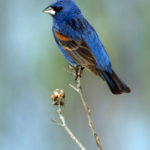
Few things develop one’s appreciation for a region as much as the native flora and fauna. Thus, the California coast, Sierra Nevada, and great southern deserts are special attractions for residents and tourists alike, each region’s allure derived from a special combination of location and unique natural features.
For decades the great Central Valley was among the least appreciated regions in the west, in part because many of its natural features had been radically altered by man. It is one of the most engineered and managed regions in the west. As people began to realize the importance of the Valley’s grasslands, rivers, wetlands and riparian forests, a movement was begun to restore some of these lost natural treasures.
One such restoration effort is the San Joaquin River National Wildlife Refuge near the confluence of the Tuolumne, San Joaquin and Stanislaus Rivers, west of Modesto. The Refuge features the beginnings of what may well become the largest riparian forest in the west, as well as some superb wetlands and grasslands.
The most obvious beneficiary of the Refuge thus far is the formerly endangered Aleutian Canada Goose, which fifty years ago numbered fewer than six-hundred birds. The Aleutian Goose population is now in the neighborhood of one-hundred thousand birds. But the Aleutian Goose is only part of the story, as many other birds and animals have benefitted from the restoration of their natural habitats, including River Otters, Long-tailed Weasels, Coyotes, Raccoons, and myriad other species of waterfowl.
Among the more exotic birds to have gained a stronger presence in the Northern San Joaquin Valley, the Blue Grosbeak is one of the most fascinating. Despite the males’ vibrantly blue plumage, Blue Grosbeaks were seldom seen until recent years, mostly because what was left of their favored habitat was on private property.
Now that the Grosbeaks have more habitat and now that the public has more access, Blue Grosbeaks can be seen on most trips to the proper location at the proper time of the year. In fact, Blue Grosbeaks should be returning to the Refuge any time now, following their winter vacations in Northern Mexico south to Panama. They usually arrive around the first of April, but many species have been arriving early this year, probably because of the mild winter.
With their swollen bills and brilliant blue plumage, male Blue Grosbeaks are unmistakable. Females have the same swollen bill, but are a soft cinnamon brown color, sometimes with a pale blue wash on the rump and tail.
Nature lovers with a yen to see this beautiful blue Northern San Joaquin Valley endemic species can look along both sides of Beckwith Road, especially near the U.S. Fish and Wildlife platform, or, better yet, walk the Pelican Trail at the new Refuge expansion, just east of River Road. From Highway 132, drive south on River Road to Dairy Road and turn left. The Refuge entrance is at the end of Dairy Road. Walk the Pelican Trail as you search for the Blue Grosbeaks, which are often feeding in the plants and shrubs along the trail, and enjoy the natural wonders along the way.

[…] of what to look for, but where and when to find it. Thus, those who wished to see the spectacular Blue Grosbeak, our most recently featured, “Target Bird,” were limited to a few locations where the bird […]